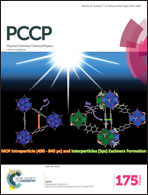Computational study on the unbinding pathways of B-RAF inhibitors and its implication for the difference of residence time: insight from random acceleration and steered molecular dynamics simulations†
Abstract
B-RAF kinase is a clinically validated target implicated in melanoma and advanced renal cell carcinoma (RCC). PLX4720 and TAK-632 are promising inhibitors against B-RAF with different dissociation rate constants (koff), but the specific mechanism that determines the difference of their dissociation rates remains unclear. In order to understand the kinetically different behaviors of these two inhibitors, their unbinding pathways were explored by random acceleration and steered molecular dynamics simulations. The random acceleration molecular dynamics (RAMD) simulations show that PLX4720 dissociates along the ATP-channel, while TAK-632 dissociates along either the ATP-channel or the allosteric-channel. The steered molecular dynamics (SMD) simulations reveal that TAK-632 is more favorable to escape from the binding pocket through the ATP-channel rather than the allosteric-channel. The PMF calculations suggest that TAK-632 presents longer residence time, which is in qualitative agreement with the experimental koff(koff = 3.3 × 10−2 s−1 and ΔGoff = −82.17 ± 0.29 kcal mol−1 for PLX4720; koff = 1.9 × 10−5 s−1 and ΔGoff = −39.73 ± 0.79 kcal mol−1 for PLX4720). Furthermore, the binding free decomposition by MM/GBSA illustrates that the residues K36, E54, V57, L58, L120, I125, H127, G146 and D147 located around the allosteric binding pocket play important roles in determining the longer residence time of TAK-632 by forming stronger hydrogen bond and hydrophobic interactions. Our simulations provide valuable information to design selective B-RAF inhibitors with long residence time in the future.


 Please wait while we load your content...
Please wait while we load your content...